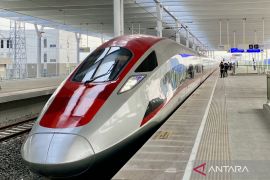In the early 19th century, Governor-General Herman Willem Daendels mobilized forced labor to develop the Great Post Road connecting Anyer in Banten to Panarukan in East Java, with the road connecting Jakarta (then Batavia) to Bandung being one of its sections.
Fast forward to the independence era, toll roads connecting Jakarta to Cikampek, and then from Cikampek to Padalarang and Bandung, were developed under successive leaderships from Suharto to Susilo Bambang Yudhoyono.
Now, after thousands of kilometers of toll roads have been developed nationwide under the leadership of President Joko Widodo (Jokowi), the government is developing the Jakarta-Bandung High-Speed Railway (KCJB) network to continue boosting connectivity between the two main cities on Java Island.
The project, developed in cooperation between Indonesia and China, through its operator PT Kereta Cepat Indonesia-China (KCIC), will conclude soon after its five-year construction.
The high-speed railway system puts Indonesia one step ahead of Southeast Asian countries as it is the first of its kind in the region.
Starting from May 2023, the railway system underwent a commissioning test, and the high-speed train carriage, including its inspection train, made round trips from Jakarta to Bandung on each testing day.
The testing speed has also gradually increased each day, from 80 kilometers per hour initially to over 350 kilometers per hour achieved this month, faster than the normal operation of the French TGV train that travels up to 320 kilometers per hour.
Content regarding the high-speed train test has also begun to flood social media platforms, reflecting the level of enthusiasm among residents for the new railway system and its operation.
Translator: Bagus Ahmad R, Nabil Ihsan
Editor: Anton Santoso
Copyright © ANTARA 2023












